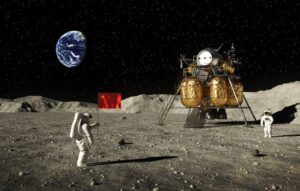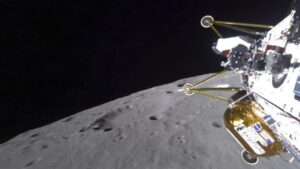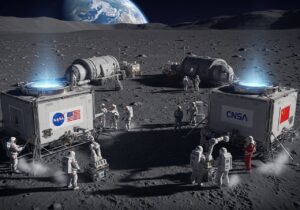
The United States is locked in a new-era space race with China, vying to claim the most resource-rich region of the Moon, according to Sean Duffy, the interim administrator of NASA. Speaking at a press conference titled “Unleashing American Drone Dominance”—hosted by the US Department of Transportation, which he also heads—Duffy revealed bold plans to install a nuclear power reactor on the lunar surface by the year 2030.
“We’re in a race to the Moon, a race with China,” Duffy stated. “And to have a base on the Moon, we need energy.”
Duffy emphasized that the lunar region both the US and China are targeting is not just symbolic—it holds immense practical value. “There’s a certain part of the Moon that everyone knows is the best,” he said. “We have ice there. We have sunlight there. We want to get there first and claim that for America.”
The area he referenced is widely believed to be the Moon’s south pole—a region known for its vast reserves of water ice buried in permanently shadowed craters, as well as areas that receive near-continuous sunlight. Together, these resources could support human life and enable the generation of solar and nuclear power, making the region essential for establishing a sustainable lunar base.
The Power of a Nuclear Reactor

Central to NASA’s vision is the development and deployment of a 100-kilowatt nuclear fission reactor. Duffy explained that such a system would provide a reliable energy source necessary to power lunar habitats and operations, especially in areas where sunlight is limited or inconsistent.
“We are in a race with China to the moon”: Acting NASA chief Sean Duffy says “we need to get our act together” when it comes to the space race, saying it is “critically important” for the U.S. to fast-track a nuclear reactor to the moon.
More: https://t.co/uNsyFRyHcO pic.twitter.com/WuyoFXNM5a
— NewsNation (@NewsNation) August 5, 2025
“This nuclear reactor would generate about the same amount of electricity that a typical American household consumes in three and a half days,” he said. “Energy is the key to permanence on the Moon. Without it, a base is not possible.”
NASA aims to place this reactor on the Moon within five years. The system, designed to withstand the harsh lunar environment, would offer a stable power supply essential for life support systems, scientific research stations, and potentially even industrial processes like mining and water extraction.
Addressing Safety Concerns

One of the major concerns surrounding the launch of nuclear material into space is safety. Duffy addressed these worries directly, assuring the public that the reactor would not be active during launch.
“We’re not launching this live,” he said. “If you have any concerns about that, rest assured—we’re taking every precaution. The reactor will only be activated once it’s safely on the Moon.”
The reactor plan is part of a broader NASA strategy to secure American leadership in space and to ensure access to key lunar resources that could prove vital for future missions, including human exploration of Mars.
Artemis Program Lacks Public Recognition
During his remarks, Duffy also reflected on the differences in public awareness between the current Artemis lunar program and the historic Apollo missions of the 1960s and 70s. While Apollo captured global attention with its dramatic moon landings, Duffy noted that many Americans are still unaware of Artemis and its objectives.

“A lot of people don’t even know what Artemis is,” he admitted. “Everyone knew Apollo. The whole world watched when we went to the Moon. But now, we’re going back—and it’s just as important, if not more so.”
The Artemis program, led by NASA in collaboration with international and commercial partners, aims to return humans to the Moon for the first time in over 50 years. Its long-term goal is to establish a sustainable human presence there, laying the groundwork for deeper space exploration.
The New Space Race
China has been rapidly advancing its space program, landing robotic missions on both the near and far sides of the Moon and recently announcing its own plans to build a lunar research station. The competition has brought back a Cold War-era sense of urgency, as both superpowers rush to secure key locations and resources on the Moon.
For the US, Duffy’s message is clear: the Moon isn’t just about exploration anymore—it’s about strategic dominance, resource control, and long-term survival in space.
“We’re not just planting a flag,” he said. “We’re building a future.”
